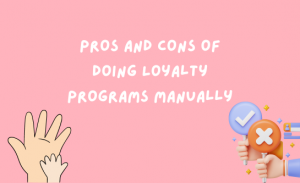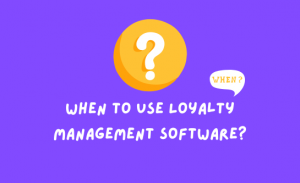Manual vs Loyalty management software: Which one?
 May 13th, 2024
May 13th, 2024
 656 views
5 MINS READ
656 views
5 MINS READ
In the modern business world, customer loyalty stands as a cornerstone for sustainable growth and success as it could increase the probability of selling goods by up to 65%, compared to selling to new prospects. Loyalty programs, in their various forms, serve as powerful tools for fostering enduring relationships with customers. Traditionally, these programs were administered through manual methods, relying on tangible incentives like punch cards or paper coupons. However, with the advent of technology, businesses now have the option to leverage sophisticated loyalty management software to streamline operations and amplify customer engagement. Hence, we will make a comparison between managing loyalty programs manually versus utilizing loyalty management software.
Pros and Cons of Doing Loyalty Programs Manually

1. Advantages of traditional loyalty programs
Simplicity
Traditional loyalty programs are inherently simplistic in their design and execution. With mechanisms like stamp cards or point systems, they offer a straightforward approach that is easy to understand for both customers and businesses alike.
Personal Connection
One of the inherent charms of traditional loyalty programs lies in their ability to foster a personal connection between businesses and their customers. Handwritten thank-you notes, personalized rewards, and face-to-face interactions contribute to a sense of appreciation and loyalty.
Accessibility
Traditional loyalty programs are inclusive by nature, catering to customers of all demographics, including those who may not be technologically inclined or lack access to digital devices.
2. Disadvantages of traditional loyalty programs
Limited Data Insights
Despite their effectiveness in driving customer engagement, traditional loyalty programs often fall short of providing comprehensive data insights. The absence of robust analytics capabilities makes it challenging for businesses to gain deep insights into customer behavior and preferences.
Administrative Overhead
Managing traditional loyalty programs can entail a significant administrative burden, particularly for businesses with a large customer base. Manual tracking of transactions, rewards, and customer interactions can be time-consuming and prone to errors.
Scalability Challenges
As businesses expand their operations across multiple locations or channels, traditional loyalty programs may struggle to scale efficiently. Standardizing program offerings and maintaining consistency across various touchpoints can pose logistical challenges.
Pros and Cons of Loyalty Management Software
1. Advantages of Loyalty Management Software
Advanced Analytics
Loyalty management software empowers businesses with advanced analytics tools that provide invaluable insights into customer behavior, preferences, and trends. By leveraging data-driven strategies, businesses can tailor their marketing efforts, personalize rewards, and optimize the overall customer experience.
Automation and Efficiency
One of the primary advantages of loyalty management software lies in its automation capabilities. From reward tracking and customer communication to campaign management, automation streamlines operations, reduces administrative overhead, and enhances operational efficiency.
Scalability and Adaptability
Loyalty program management is highly scalable and adaptable, making it suitable for businesses of all sizes and complexities. Whether operating a single storefront or a global franchise network, businesses can customize and deploy loyalty programs seamlessly across diverse channels and locations.
2. Disadvantages of Loyalty Management Software
Initial Investment
Implementing loyalty management software requires a significant initial investment in terms of technology infrastructure, software licenses, and staff training. For small businesses with limited financial resources, this upfront cost can present a barrier to entry.
Technical Complexity
Loyalty management software may entail a learning curve for businesses unfamiliar with the technology. Customization, integration with existing systems, and ongoing maintenance may require technical expertise or external support.
Dependency on Technology
Loyalty management software relies heavily on technology infrastructure, including point-of-sale (POS) systems, mobile applications, and cloud servers. Any disruptions or technical issues can potentially disrupt program operations and compromise the customer experience.
When to Use Loyalty Management Software

1. Data-Driven Business
Businesses that prioritize data-driven decision-making and actionable insights should consider adopting loyalty management software. These platforms offer advanced analytics tools that provide valuable insights into customer behavior, preferences, and trends, enabling businesses to tailor their marketing strategies accordingly.
2. Business looks for expansion
Businesses planning for growth or operating across multiple locations or channels can benefit from loyalty management software’s scalability and adaptability. These platforms can be customized and deployed seamlessly across diverse channels and locations, ensuring consistency and standardization.
3. Business seek for long-term efficiency
Businesses looking to streamline operations, reduce administrative overhead, and enhance operational efficiency should consider loyalty management software. Automation features such as reward tracking, customer communication, and campaign management simplify program management and free up resources for other strategic initiatives.
4. Online Businesses and E-commerce
Loyalty management software is particularly well-suited for online businesses and e-commerce platforms. These businesses can leverage digital channels such as mobile apps, websites, and email marketing to engage customers, track their behavior, and deliver personalized rewards effectively.
5. Tech-Savvy Customer Base
Businesses with a tech-savvy customer base or those operating in industries where digital engagement is prevalent may find loyalty management software more appealing. These customers are likely to embrace digital loyalty programs and engage more actively through online channels.
When to Use Traditional Loyalty Programs
1. Micro Businesses with Limited Resources
Traditional loyalty programs are ideal for small businesses with limited financial resources and technical expertise. These businesses may find it more cost-effective and manageable to implement simple, manual loyalty programs such as punch cards or stamp cards.
2. Offline or Brick-and-Mortar Businesses
Traditional loyalty programs are well-suited for offline or brick-and-mortar businesses that have a physical presence. These businesses can leverage tangible incentives such as in-store discounts or freebies to encourage repeat purchases and customer loyalty.
3. Small customer base
Businesses with small customer base and limited product/service offerings may find traditional loyalty programs sufficient. These programs are easy to understand and implement, so with a small pool of customers, it will not take a huge effort of business to handle and manage loyalty programs
Wrap up
Ultimately, the decision to use traditional loyalty programs or loyalty management software depends on a careful assessment of the business’s objectives, resources, and customer preferences. In some cases, a combination of both methods may be appropriate, leveraging the strengths of each approach to create a comprehensive loyalty strategy tailored to the specific needs of the business.
 Back to blog page
Back to blog page


































